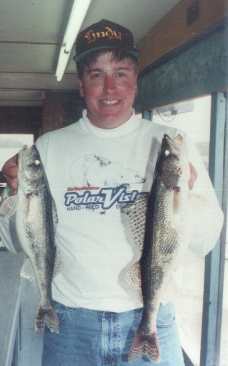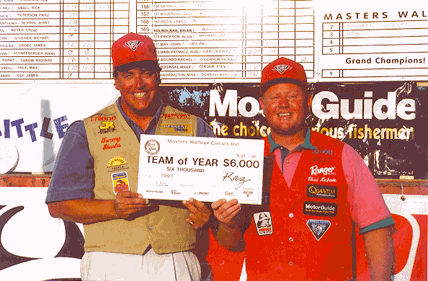
|
|||||||||||||||||||||||||||||||||||||||||||||||||||||||||||||||||||||||||||||||||||||||||||||||||||||||||||||||||||||||||||||||||||||||
|
Promotional Team Favorites Lodging food and more
|
CORNER  Tommy
Skarlis of Walker Mn is one of the hottest sticks on the tournamaent trail.
Tommy a true "River Rat" weined on the Mississippi River is just as at
home trolling the Great Lakes. Tommy finished up in 14th place overall
in the 2001 In-Fisherman Professional
Walleye Trail Angler of the year shoot-out that was decided Dunkirk New
York with a total of 246.26 lbs for the six qualifying events .
Tommy then finished 33rd overall in the 2001In-Fisherman
Professional
Walleye Trail Championship in Bismark North Dakota Tommy
Skarlis of Walker Mn is one of the hottest sticks on the tournamaent trail.
Tommy a true "River Rat" weined on the Mississippi River is just as at
home trolling the Great Lakes. Tommy finished up in 14th place overall
in the 2001 In-Fisherman Professional
Walleye Trail Angler of the year shoot-out that was decided Dunkirk New
York with a total of 246.26 lbs for the six qualifying events .
Tommy then finished 33rd overall in the 2001In-Fisherman
Professional
Walleye Trail Championship in Bismark North Dakota
SPRING VALLEY ILLINOIS TOMMY SKARLIS AND CHAD KINKADE TAKE 3RD PLACE APRIL 6 1997
Tommy Skarlis and partner Chad Kinkade, both from Waterloo, Iowa, overcame
winds up to 50 mph and dropping temperatures to place third by weighting
a total of 24.9 pounds of saugers in the Masters Walleye Circuit season
opener on the Illinois river April 5th and 6th.The veteran team started
off the first day of the tournament with whopping 13.55 pounds of sauger
good enough to secure a tie for fouth place in the 225 boat field.
Waking Sunday to gale force winds, Skarlis and Kinkade knew that they would
have there work cut out for them. "By 8:30, the wind had
come up to a constant 30 mph with gusts well around 50 mph. It was
then that we realized that in order to stay vertical we were going to have
to use the 9.9 1998 In-Fisherman Professional Walleye Trail

I use a 40\40\20 approach. In other words, I start by fishing the middle one third of the water column(in 15 feet of water this would consist of the 5 to 10 foot section) for 2 minutes(40% of 5 minutes). Then cover the bottom one third of the water column (IO feet deep down to the bottom) for 2 minutes. Then the top one third (from directly under the hole down to 5 feet deep) for one minute(20% of 5 minutes) .ROCKIN RYTHM JIGGING In each water column I start at the top and work my way down, using one inch jigging drops to create a rocking rhythm with my spring boboer. If the rhythm is broken it is almost always a bite, so I'm prepared at all times to set the hook whenever the rhythm breaks. TEASIN' THE CAT If you notice a mark on your sonar that seems interested in what your doing until you drop the jig towards it,(for example, if it backs or drops away from your presentation) lower your jig below the fish and slowly jig up past the fish with smaller and much more subtle rock-jiging movements. Stop every couple of inches or so and hold your presentation still until the fish starts to inch towards the bait, then repeat the process. Usually, sooner or later the fish will approach your presentation twice as fast as it had been. When this happens, pause and get ready to set the hook because this time the fish is coming to get supper. THE DEAD ROD In most states you have the option of using multiple rods. Whenever this option is available, I'll jig with one rod and fish about two feet away with a "dead" rod with either a small ice jig and a wax worm set about 6 inches off of the bottom for bluegills and an occasional crappie, or with a minnow when trying to target crappies. If the crappies aren't very aggressive, squash the minnow. It's always amazed me at how this would turn on a fish more than the live throbbing equivalent, but it produces. The beautiful thing about the two rod system is that if a fish comes in on the jig, it might bite the dead rod or vice versus. PRODUCTS THAT WILL INCREASE YOUR ICE FISHING SUCCESS ICE AUGERS
SIRIKEMASTER LAZER MAG This 2.0 HP, 49cc Tecumseh powered auger is a beauty. With dual "Chrome Alloy" stainless steel serrated LAZER blades, it is the lightest weight power auger that will cut through an old fishing hole with the same case as cutting a new hole. It has a rustproof white gas tank that allows the operator to visually see the fuel level, plus coated handles for greater control. A must for the serious ice angler. STRIKEMASTER LAZER XL 3000 Almost identical features as the LAZER MAG with the exceptions of a rustproof gas tank that is not translucent, but with 3.0 BP to offer the ice angler one of the most powerful augers available .STRIKEMASTER ELECTRA LAZER With the same cutting blades as the LAZER MAG and THE LAZER XL-3000, the ELECTRA LAZER is powered by 12 volts, draws only 8 to 10 amps, and is the only environmentally sound power auger on the market. With no smell and no gas fumes combined with the lazer blades ability to re-cut old ice fishing holes, it is the perfect auger for the ice angler that chooses to fish out of a permanent ice house .SONAR I've been using sonar on the Ice now for five years and it has completely revolutionized the way that I fish and has improved my success immensely. Below are some of the products that I've found to work the best: STRIKEMASTER POLAR VISION With the exterior shape and size of a standard flashlight, the POLAR VISION hand held digital sonar that allows you to read water depths of 3' to 199'through even the most severest of ice conoitions, and is powerful enough to read accurately through the bottom of a boat or c4noQ for the open water angler. Weighing in at only 1.5 lbs it has a carrying strap, is waterproof and it floats, has a visual and audible fish alarm, automatic shut- off, LCD display with Backlight for night use, and the case is impact resistant. I use it to find depth breakllines and it is especially handy when I need to locate a creek channel or rock pile. ZERCOM ICE SYSTEMS The best units that I've found for ice fishing applications are the Clearwater Classic and LCF40 Ice Systems manufactured by Zercom. The systems are equipped with gel-pack batteries that will power the units for up to I 00 hours before re-charging is required. The LCF-40 and the Clearwater Pro both offer self-aligning transducers so that you.can spend more time fishing and less time adjusting you're transducer. All Zercom units offer the unique patented feature called Time Variable Gain or TVG. This feature allows the unit to mark a target and show it as the same size in five feet of water as it is when it is thirty-five feet deep. The units are so sensitive, that I've had them ark knots in my line, not to mention the tiniest of ice these With two inches of target separation and the added benefit of the units unique gray scaling, I can tell the size of a fish, where it is located in my transducer cone, or how many fish are down there (on other units two small panfish wiII usually show up as one big one). Fish resting on the bottom are even easy to identify. 1999 PWT Schedule
Fish Clix Banner Exchange Please visit these site sponsors |
||||||||||||||||||||||||||||||||||||||||||||||||||||||||||||||||||||||||||||||||||||||||||||||||||||||||||||||||||||||||||||||||||||||
|---|---|---|---|---|---|---|---|---|---|---|---|---|---|---|---|---|---|---|---|---|---|---|---|---|---|---|---|---|---|---|---|---|---|---|---|---|---|---|---|---|---|---|---|---|---|---|---|---|---|---|---|---|---|---|---|---|---|---|---|---|---|---|---|---|---|---|---|---|---|---|---|---|---|---|---|---|---|---|---|---|---|---|---|---|---|---|---|---|---|---|---|---|---|---|---|---|---|---|---|---|---|---|---|---|---|---|---|---|---|---|---|---|---|---|---|---|---|---|---|---|---|---|---|---|---|---|---|---|---|---|---|---|---|---|---|







